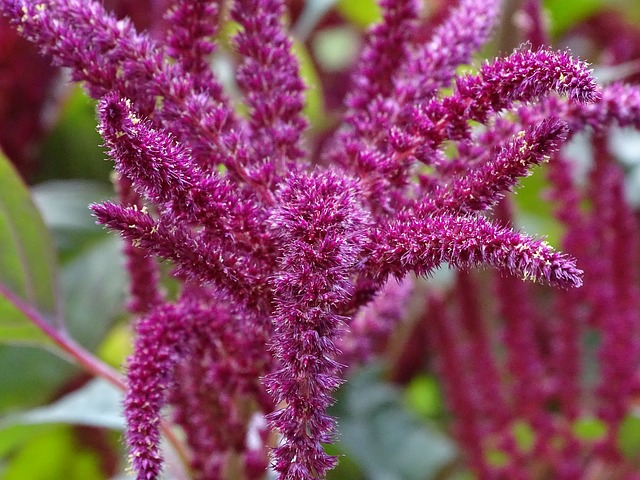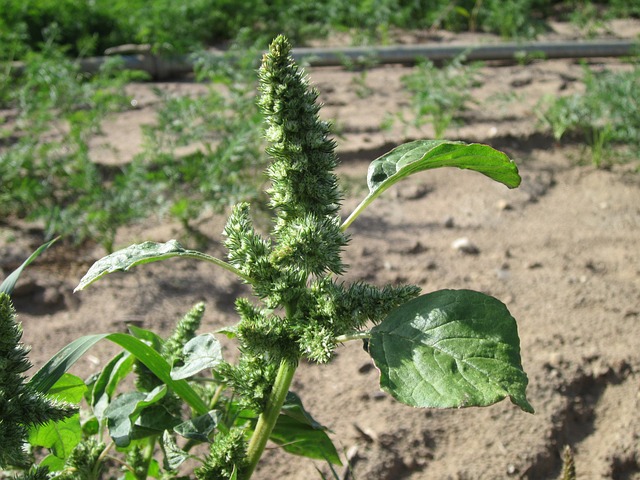  |   |  |   |  |
 |  |  |
Amaranths are in most cases annual or perennial herbaceous plants 15-80 cm high. The whole plant is colored green or purple-red. Some species (upturned amaranth) with root crops. Leaves alternate, entire, without stipules, rhomboid, lanceolate or ovate. The leaf blade at the base is elongated into a petiole, the apex is notched and has a small point. The upper leaves have very short petioles, the lower ones are long-petioled, while the former do not shade the lower leaves, since their petioles grow until the leaf blade emerges from the shadow of the upper leaves. The flowers are small, usually actinomorphic (regular), petalless, hidden among pointed green bracts, bisexual. There are monoecious and dioecious species. Axillary flowers in small glomeruli, apical flowers are collected in dense spicate paniculate inflorescences. Calyx of 5 (1-4) usually dry and membranous sepals or without them. Stamens 5. Gynoecium of 2-3 (4) carpels.
The fruit is a nut, less often a box. The seeds are numerous, rather small, smooth, in a strong peel, well adapted to falling out of the fruit (barochory phenomenon) and spreading with the soil. Each of the well-developed specimens produces hundreds of thousands of seeds.
The preparation of raw materials is carried out in different ways. Amaranth is harvested at the end of summer after flowering has ended so that it is mature enough. But there are species that need to be collected in winter. At home, the seeds must be manually removed from the boxes, in industrial conditions, harvesting is carried out using a combine. Flowers and stems of amaranth are frozen, dried or fermented like ordinary cabbage. When drying, medium-sized cut pieces of the plant are laid in a small layer in a well-ventilated place, sometimes stirred, or amaranth leaves are collected in a small bundle, hung up and dried (if the plant crumbles, then it has dried up). If it is necessary to preserve a large amount of nutrients, the plant is also cut into small pieces, put in the refrigerator. Store dried raw materials in a dry, darkened and ventilated room in a suspended state. When freezing in bunches, amaranth bunches are washed and dried, put in bags, then in the freezer. Frozen parts of the plant are stored for no more than a year until the raw materials lose their useful properties. They also pickle in two ways, for the first - they make a brine (salt and sugar), for the second (dry) method - the bouquets are simply covered with salt and placed in containers.
Currently, amaranths are considered health pantries because they contain a large amount of valuable substances.
MEDICINAL IMPORTANCE
Omega-6 polyunsaturated fatty acids contained in amaranth have a positive effect on cholesterol metabolism, prevent the development of atherosclerosis; vitamin E - a powerful antioxidant, delays aging and prevents cardiovascular diseases, reduces the formation of blood clots and cholesterol plaques, strengthen the myocardium; squalene increases the body's resistance (immunity) to various diseases, protects cells from radiation and malignant degeneration, and also protects the skin from exposure to harmful substances and prevents the development of skin cancerous tumors, provides moisture, slows down skin aging, and helps to saturate the body with large portions of oxygen. Pro-vitamin A, vitamins E, D, polyunsaturated fatty acids and other oil substances slow down the process of early skin aging and promote skin rejuvenation. Amaranth is an ideal remedy for restoring the body after chemotherapy.
Amaranth has been used since ancient times to treat many diseases. In folk medicine, amaranth is interesting as a source of many healing substances, it is used for heart diseases, gastrointestinal infections, eczema, psoriasis, dermatitis, erosions, endometriosis, colitis, and externally for fungal diseases. Amaranth infusion is used to treat diseases of the kidneys and liver, as well as enuresis and inflammation of the genitourinary system. Juice from fresh amaranth leaves is used for pain in the stomach, gastritis, diabetes. A tincture of dried seeds and leaves of amaranth is used to prevent flu and colds. An amaranth bath is taken to treat skin diseases, allergies, diathesis, rashes. Amaranth seed oil is used to treat burns, bedsores, insect bites, and scars. Sprouted amaranth seeds are used to treat cancer. Juice and tincture of amaranth can be used as an antitumor agent both internally and externally. A decoction of amaranth roots is used against guinea worm and jaundice. A decoction of the roots and seeds is also used for dysentery. In case of inflammation of the mucous membranes of the oral cavity, amaranth juice is used in a ratio of 1: 5 for rinsing. To rejuvenate the body and remove harmful substances from it, take in equal parts the collection of herbs amaranth, St. John's wort, birch buds, medicinal chamomile. In Chinese medicine, amaranth is used to fight tumors and slow down the aging process. In case of inflammation of the mucous membranes of the oral cavity, amaranth juice is used in a ratio of 1: 5 for rinsing. To rejuvenate the body and remove harmful substances from it, take in equal parts the collection of herbs amaranth, St. John's wort, birch buds, medicinal chamomile. In Chinese medicine, amaranth is used to fight tumors and slow down the aging process. In case of inflammation of the mucous membranes of the oral cavity, amaranth juice is used in a ratio of 1: 5 for rinsing. To rejuvenate the body and remove harmful substances from it, take in equal parts the collection of herbs amaranth, St. John's wort, birch buds, medicinal chamomile. In Chinese medicine, amaranth is used to fight tumors and slow down the aging process.
Common Amaranth (Amaranthus retroflexus L.)

